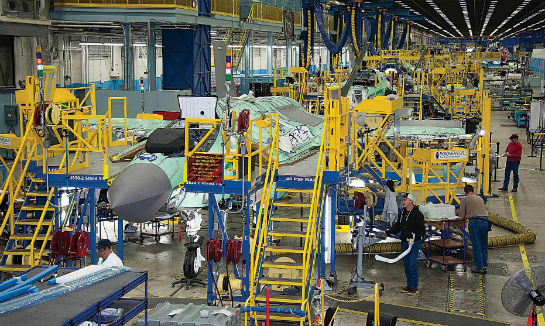Estimated reading time 10 minutes, seconds.

More than 100 Canadian companies have been awarded contracts, worth $825 million, to supply components for the Lockheed Martin F-35. Lockheed Martin Photo
Editor’s note: Tremendous value can come from exporting outside of Canada. Aerospace companies who have reaped these benefits can be large or small; however, bigger Canadian companies are generally more equipped to export because they have an already-established global reach. Smaller and medium-sized firms may find the process more challenging. Here, experienced industry consultant Linda Wolstencroft presents a few tips for Canadian aviation and aerospace companies looking to do business beyond our borders.
Anyone in aviation or aerospace can–and indeed should–export. This especially applies to you if you are a manufacturer or a service provider. This includes companies that provide pure services such as engineering, logistics, project management, training, labour or software, as well as companies in manufacturing and MRO (maintenance, repair and overhaul).
Typically, a company can springboard a domestic capability of providing a product or service into an international market opportunity.
But it is not enough to simply possess that capability–company leaders must work hard at developing it. In one example, an organization’s leadership commitment was so deep that within a time frame of two to three years, several new contracts were won, amounting to more than $100 million. This company was strongly focused on achieving these wins; the company president handpicked the execution team and was hands-on throughout the process, challenging them to do whatever it took to win the business.
For operators, the export market possesses unique regulatory and certification requirements that vary by region; once these are overcome, the points discussed here can apply.
Successful approach
Heli-One Canada is a company built upon supporting the large CHC Helicopter fleet. Heli-One maintains diversity in its business to balance market sector volatility by pursuing work outside of CHC, including export work.
A leader in rotor-wing MRO with decades of expertise supporting a wide range of helicopters and mission types, Heli-One works to inform operators about its wide range of services, including innovative repair processes, solutions to reduce direct maintenance costs and modernization programs to extend aircraft lifespan. This strategy has proven successful with two recent contract signings in Asia, a growing rotorcraft market.
Heli-One recently won a contract to upgrade and provide maintenance for the Sultan of Johor’s two Sikorsky S-76B helicopters. This VVIP-focused project will modernize flight displays that will benefit safety and expand operational capability, in addition to enhancing His Majesty’s flight experience.
Another recent contract win is an excellent example of localized collaboration: Heli-One will be working with AIROD, a Malaysia-based MRO, to upgrade the flight displays for the Royal Malaysian Air Force’s Sikorsky S-61 helicopters. Heli-One will use its demonstrated expertise and continuing investment into MRO technology for this platform.

From its Boundary Bay facility in Delta, B.C., Heli-One offers a wide range of global services, such as innovative repair processes, solutions to reduce direct maintenance costs and modernization programs to extend aircraft lifespan. Heli-One Photo
“Our recent success in different markets can be attributed to the Heli-One team working collaboratively with operators to come up with unique MRO solutions,” said Anthony DiNota, president of Heli-One. “From our experience in supporting platforms such as the S-76 and S-61, we are uniquely positioned to provide offerings that span from nose to tail, leveraging knowledge gained from decades of service. Our team is excited to share with operators the depth of options available to them that will maximize their aircraft’s operational capability.”
Other companies have been successful at the international negotiating table through careful management of their customer relationships. One organization decided to go over the head of its prime contractor to relate directly with the foreign customer. This bold move became highly advantageous to the domestic company because the power struggle ultimately brought more value for the aggressive company in the ensuing negotiation. For a smaller company with less power, this is an option but only if done carefully.
Relationships still rule
Just as with any business transaction, the strength of relationships is the dominant factor in exporting. Without a multi-level, multi-disciplinary pattern of relationships that are deliberately fostered by the exporter, the chances of success are significantly lowered. If the relationship with the foreign customer is left to one or two people, it rarely works well. This is a matter that requires more relationships.
To benchmark, count the number of relationships in your company that are established with your existing domestic customers. Then, count the number of relationships that are established in the international work. The numbers should not be too far apart. And, by the time new business is won, these numbers should almost be equal.
When exporting, relationship management is more complex because there are more entities involved. The most successful export business transactions make use of Canadian government entities that can help.
These include the Canadian Commercial Corporation (CCC), the Trade Commissioner Service (TCS) and Export Development Canada (EDC). These entities offer companies expert assistance to help manage the risks associated with exporting, at low or no cost.
With the exception of U.S. customers (with whom we share a common understanding of business norms and culture), it is crucial to heed the advice of in-country representatives. Some firms choose not to listen to these advisors; some have taken the egotistical approach in believing that the way the other country does business is wrong and should be changed.
Instead of trying to understand the country’s business norms, these companies worked against them. This is a lack of open-mindedness that prevents understanding of the legitimate reasons why, for instance, business done in Mexico differs from that in Canada. Thinking that one’s country is “smarter” than another country only serves to decrease the chance of successfully transacting foreign business.
Inviting the customer to visit your facility or travelling to meet face-to-face are imperative activities. As long as the business opportunity has been properly qualified and has been assessed as having a relatively high probability of win, the travel investment is almost always worth it.
Your customer value proposition
As with any business sale, it’s vital to know the customer value proposition you are offering.
• Are you offering the lowest total price?
• Do you offer a relationship solution that is valuable and better than the other options?
• Do you have a unique product or possess some intellectual property that is yours alone?
• Can you offer a superior service?
• Do you have a long-term solution that will yield higher long-term value than your customer can get elsewhere?
These are recognized as the fundamental basic customer value propositions that you must offer to any of your customers, wherever they are. When you travel, you must bring this with you.
Principles of success
The principles of success to win international business do not differ much from what it takes to win domestic business. Two of the main contributors to success remain organizational focus and perseverance and maintaining customers’ trust and loyalty.
Dedicated team members who are patient, value success and have a strong work ethic will bring focus and perseverance to the endeavour. While not necessarily having to stay up all night, dedication means more than just being a nine-to-fiver. It involves caring about the project and always thinking “what next?”
If there is a lack of activity and a lack of communication with the customer, that is a bad sign. Don’t wait for something to happen or assume you know what’s next. Waiting is hardly ever the right thing to do, and making assumptions about what is really going on can be deadly.
In many cultures outside North America, trust and loyalty matter more than price or the technical solution offered. A contract award may be offered that doesn’t honour the best offer, but instead is based on trust. This characteristic presents an opportunity for the Canadian exporting company to be the trusted player.
Trust and loyalty can only exist in the presence of truth; lying is rarely a good tactic. Don’t lie to your customer and don’t allow lies within your team. Typical examples include badmouthing a competitor or making excessive claims that cannot be achieved. This can permanently discolour a relationship.
As well, lies within our own business team are sometimes overlooked yet are equally important to identify. In one company, an executive met with an international customer but the meeting failed and the opportunity was scuttled. The travelling executive came up with reasons why the meeting failed–not mentioning that he unintentionally offended a senior customer official. Without this truth, there was no chance for the company to correct the slip–and a good multi-million dollar opportunity was missed.
Finally, share your values. Relationships flourish when common principles are identified. Look for common values between your culture and your customer’s culture and build on those.
Today, with the help offered by the Canadian government and other experts, plus the relatively low value of the Canadian dollar, there is no reason to ignore aerospace business opportunities that wait outside our borders.
Thinking about exporting? Consider these five tips:
1. Evaluate your customer value proposition: How does your offering compare with the competition? Do you have the best product or service? The lowest price? Do you offer better customer care? Do you have an advantage politically or in relation to offsets?
2. Pick a specific opportunity: Engage with the customer and relevant Canadian government organizations for initial advice and discussions to determine your chances of success.
3. Perform an initial review of risk: Look at technical, financial and contractual risk, as well as country risk. For some countries, getting paid can be an issue, and contractual requirements may contain performance bonds and guarantees, which add costs.
4. Plan for cultural differences: Determine how the culture of the customer differs from your own and what you will do to address it. Be mindful of bribery and anti-corruption laws.
5. Find a partner: In-country representation is almost always necessary. Teaming with another firm more familiar with the market is another good approach.
Linda Wolstencroft offers expert assistance in winning new domestic and international business, bringing over 25 years’ experience and more than $1.5 billion total in contract awards for various firms.

